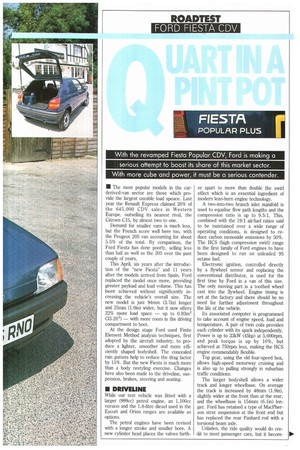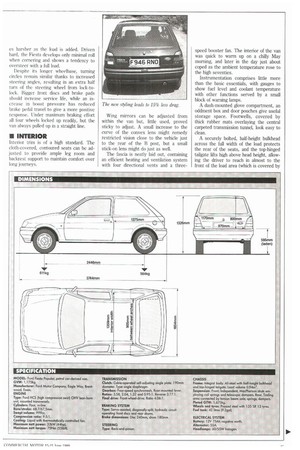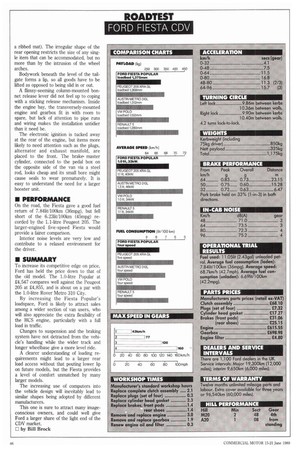With the revamped Fiesta Popular CDV, Ford is making a
Page 45

Page 47

Page 48

If you've noticed an error in this article please click here to report it so we can fix it.
serious attempt to boost its share of this market sector. With more cube and power, it must be a serious contender.
• The most popular models in the carderived-van sector are those which provide the largest useable load spe_ace. Last year the Renault Express claimed 26% of the 645,000 CDV sales in Western Europe, outselling its nearest rival, the Citroen C15, by almost two to one.
Demand for smaller vans is much less, but the French score well here too, with the Peugeot 205 van accounting for about 5.5% of the total. By comparison, the Ford Fiesta has done poorly, selling less than half as well as the 205 over the past couple of years.
This April, six years after the introduction of the "new Fiesta" and 11 years after the models arrived from Spain, Ford replaced the model once more, providing greater payload and load volume. This has been achieved without significantly increasing the vehicle's overall size. The new model is just 94mm (3.7in) longer and 25mm (1.0in) wider, but it now offers 22% more load space — up to 0.93m3 (33.2ft3) — with more room in the driving compartment to boot.
At the design stage Ford used Finite Element Method analysis techniques, first adopted by the aircraft industry, to produce a fighter, smoother and more efficiently shaped bodyshell. The concealed rain gutters help to reduce the drag factor by 15%. But the new Fiesta is much more than a body restyling exercise. Changes have also been made to the driveline, suspension, brakes, steering and seating.
• DRIVELINE
While our test vehicle was fitted with a larger (999cc) petrol engine, an 1,100cc version and the 1.8-litre diesel used in the Escort and Orion ranges are available as options.
The petrol engines have been revised with a longer stroke and smaller bore. A new cylinder head places the valves furth er apart to more than double the swirl effect which is an essential ingredient of modern lean-bum engine technology.
A two-into-two branch inlet manifold is used to equalise flow path lengths and the compression ratio is up to 9.5:1. This, combined with the 19:1 air/fuel ratios said to be maintained over a wide range of operating conditions, is designed to reduce carbon monoxide emissions by 50%. The HCS (high compression swirl) range is the first family of Ford engines to have been designed to run on unleaded 95 octane fuel.
Electronic ignition, controlled directly by a flywheel sensor and replacing the conventional distributor, is used for the first time by Ford in a van of this size. The only moving part is a toothed wheel cast into the flywheel. Engine timing is set at the factory and there should be no need for further adjustment throughout the life of the vehicle.
Its associated computer is programmed to take account of engine speed, load and temperature. A pair of twin coils provides each cylinder with its spark independently. Power is up to 33kW (45hp) at 5,000rpm, and peak torque is up by 10%, but achieved at 750rpm less, making the HCS engine commendably flexible.
Top gear, using the old four-speed box, allows high-speed motorway cruising and is also up to pulling strongly in suburban traffic conditions.
The larger bodyshell allows a wider track and longer wheelbase. On average the track is increased by 48mm (1.9in), slightly wider at the front than at the rear, and the wheelbase is 154mm (6.1M) longer. Ford has retained a type of MacPherson strut suspension at the front end but has replaced the rear Panhard rod with a torsional beam axle.
Unladen, the ride quality would do credit to most passenger cars, but it becom es harsher as the load is added. Driven hard, the Fiesta develops only minimal roll when cornering and shows a tendency to oversteer with a full load.
Despite its longer wheelbase, turning circles remain similar thanks to increased steering angles, resulting in an extra half turn of the steering wheel from lock-tolock. Bigger front discs and brake pads should increase service life, while an increase in boost pressure has reduced brake pedal travel to give a more positive response. Under maximum braking effort all four wheels locked up readily, but the van always pulled up in a straight line.
III INTERIOR Interior trim is of a high standard. The cloth-covered, contoured seats can be adjusted to provide ample leg room and backrest support to maintain comfort over long journeys. Wing mirrors can be adjusted from within the van but, little used, proved sticky to adjust. A small increase to the curve of the convex lens might remedy restricted vision close to the vehicle just to the rear of the B post, but a small stick-on lens might do just as well.
The fascia is neatly laid out, containing an efficient heating and ventilation system with four directional vents and a three
speed booster fan. The interior of the van was quick to warm up on a chilly May morning, and later in the day just about coped as the ambient temperature rose to the high seventies.
Instrumentation comprises little more than the basic essentials, with gauges to show fuel level and coolant temperature with other functions served by a small block of warning lamps.
A dash-mounted glove compartment, an oddment box and door pouches give useful storage space. Footwells, covered by thick rubber mats overlaying the central carpeted transmission tunnel, look easy to clean.
A securely bolted, half-height bulkhead across the full width of the load protects the rear of the seats, and the top-hinged tailgate lifts high above head height, allowing the driver to reach in almost to the front of the load area (which is covered by a ribbed mat). The irregular shape of the rear opening restricts the size of any single item that can be accommodated, but no more than by the intrusion of the wheel arches.
Bodywork beneath the level of the tailgate forms a Lip, so all goods have to be lifted as opposed to being slid in or out.
A flimsy-seeming column-mounted bonnet release lever did not feel up to coping with a sticking release mechanism. Inside the engine bay, the transversely-mounted engine and gearbox fit in with room to spare, but lack of attention to pipe runs and wiring makes the installation untidier than it need be.
The electronic iginition is tucked away at the rear of the engine, but items more likely to need attention such as the plugs, alternator and exhaust manifold, are placed to the front. The brake master cylinder, connected to the pedal box on the opposite side of the van via a steel rod, looks cheap and its small bore might cause seals to wear prematurely. It is easy to understand the need for a larger booster unit.
• PERFORMANCE
On the road, the Fiesta gave a good fuel return of 7.841it/100km (36mpg), but fell short of the 6.231it/1001an (45mpg) recorded by the 1.1-litre Peugeot 205. The larger-engined five-speed Fiesta would provide a fairer comparison.
Interior noise levels are very low and contribute to a relaxed environment for the driver.
• SUMMARY
To increase its competitive edge on price, Ford has held the price down to that of the old model. The 1.0-litre Popular at £4,547 compares well against the Peugeot 205 at £4,855, and is about on a par with the 1.0-litre Rover Metro 310 City.
By increasing the Fiesta Popular's loadspace, Ford is likely to attract sales among a wider section of van users, who will also appreciate the extra flexibility of the HCS engine, particularly with a full load in traffic.
Changes to suspension and the braking system have not detracted from the vehicle's handling while the wider track and longer wheelbase give a more level ride.
A clearer understanding of loading requirements might lead to a larger rear load access without that pouting lower lip on future models, but the Fiesta provides a level of comfort unmatched by many larger models.
The increasing use of computers into the vehicle design will inevitably lead to similar shapes being adopted by different manufacturers.
This one is sure to attract many imageconscious owners, and could well give Ford a larger share of the light end of the CDV market.
o by Bill Brock




























































































































































































